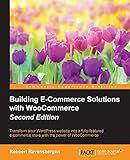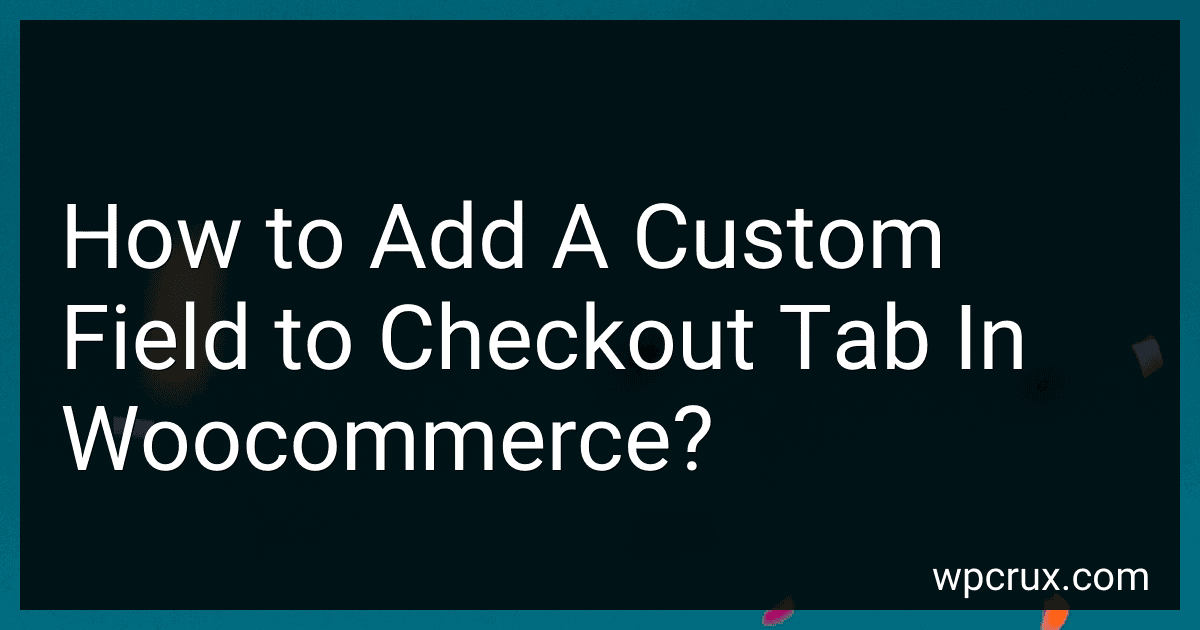Best Plugins for WooCommerce Customization to Buy in October 2025

The Ultimate WordPress & WooCommerce Handbook: From Setup to Success in Online Selling



WordPress WooCommerce: Tienda online con WooCommerce (Spanish Edition)



Building E-Commerce Solutions with WooCommerce - Second Edition



WordPress WooCommerce: Webshop met WooCommerce (Dutch Edition)



Formation Woocommerce: Créer et exploiter une boutique en ligne (French Edition)



Setting Up and Running an Online Store


To add a custom field to the checkout tab in WooCommerce, you will need to modify the functions.php file in your theme or create a custom plugin. You can use the WooCommerce hooks and filters to add the custom field to the checkout form.
First, you will need to create the custom field using the woocommerce_checkout_fields filter. You can add the custom field by specifying the field type, label, and any other attributes you want to include.
Next, you will need to save the custom field data to the order using the woocommerce_checkout_update_order_meta action hook. This will ensure that the custom field data is saved when the order is processed.
Finally, you can display the custom field data on the order details page using the woocommerce_order_details_after_order_table action hook. This will show the custom field data to the customer when they view their order.
By following these steps, you can easily add a custom field to the checkout tab in WooCommerce and customize the checkout process for your customers.
What is the impact of custom fields on the functionality of WooCommerce checkout?
Custom fields can have a significant impact on the functionality of the WooCommerce checkout process. By allowing customers to input additional information or preferences, custom fields can enhance the user experience and provide more personalized service.
Some of the key ways in which custom fields can impact the functionality of the WooCommerce checkout include:
- Enhanced customer experience: Custom fields allow customers to provide specific information or requirements related to their order, such as special delivery instructions or gift messages. This can help to improve the overall shopping experience and make customers feel more valued.
- Improved product customization: Custom fields can be used to collect additional details about a customer's order, such as size, color, or personalization options. This can help to streamline the order fulfillment process and ensure that customers receive the products they want.
- Data collection and analysis: Custom fields can be used to collect valuable customer data that can be used for marketing purposes or to improve the customer experience. By asking for input on specific preferences or interests, businesses can tailor their marketing efforts to better meet the needs of their target audience.
- Enhanced payment options: Custom fields can also be used to collect additional payment information, such as a billing address or VAT number. This can help to streamline the checkout process and reduce the likelihood of payment errors.
Overall, custom fields can play a key role in enhancing the functionality of the WooCommerce checkout process and improving the overall shopping experience for customers. Businesses can leverage custom fields to collect valuable data, enhance product customization, and provide customers with a more personalized service.
How to display custom field data on the order confirmation page?
To display custom field data on the order confirmation page, you will need to modify the template file for the order confirmation page in your website's theme. Here is a general guide on how to do this:
- Locate the template file for the order confirmation page in your theme folder. This file is typically named something like 'order-confirmation.php' or 'thankyou.php'.
- Open the template file in a text editor or code editor.
- Find the section of the code where the order details are being displayed. This is usually where the order items, total amount, and shipping information are shown.
- To display custom field data, you will need to use a function to retrieve the data from the order and then echo it out in the desired location. The function you use will depend on how the custom field data is stored. If the custom field data is stored as order meta data, you can use functions like get_post_meta() to retrieve the data.
- Insert the appropriate code to retrieve and display the custom field data in the desired location on the order confirmation page template. Here is an example of how you might display a custom field named 'Custom Field 1':
$custom_field_data = get_post_meta( $order->get_id(), 'Custom Field 1', true ); if ( ! empty( $custom_field_data ) ) { echo 'Custom Field 1: ' . $custom_field_data; }
- Save the changes to the template file and refresh the order confirmation page on your website to see the custom field data displayed.
Please note that the exact code and functions you need to use may vary depending on how your custom field data is stored and the structure of your theme files. If you are not comfortable with modifying theme files directly, you may want to consider hiring a developer to help you with this customization.
How to remove unwanted custom fields from the checkout tab in WooCommerce?
To remove unwanted custom fields from the checkout tab in WooCommerce, you can follow these steps:
- Go to your WordPress dashboard and navigate to WooCommerce > Settings.
- Click on the "Checkout" tab.
- Scroll down to the "Checkout Options" section.
- Find the custom field that you want to remove and uncheck the box next to it.
- Click on the "Save changes" button to apply the changes.
Alternatively, you can use a code snippet to remove custom fields from the checkout page. Here is an example:
add_filter( 'woocommerce_checkout_fields' , 'remove_custom_checkout_fields' );
function remove_custom_checkout_fields( $fields ) { unset($fields['billing']['billing_custom_field']); return $fields; }
Replace 'billing_custom_field' with the actual name of the custom field you want to remove.
Add this code to your theme's functions.php file or use a plugin like Code Snippets to add the code snippet to your site. This will remove the specified custom field from the checkout page.
How to set default values for custom fields on the checkout page?
To set default values for custom fields on the checkout page, you will typically need to edit the code of your e-commerce platform or use a plugin that allows for this customization. Here is a general guide on how you can achieve this:
- Identify the custom fields you want to set default values for on the checkout page. This could include fields like "Special Instructions" or "Gift Message" that you want to pre-fill for your customers.
- Access the file where the checkout page code is located. This could be a template file in your e-commerce platform's theme folder or a plugin file if you are using a plugin for customization.
- Look for the section of code where the custom fields are being generated on the checkout page. This is where you will be able to add default values.
- Add the default values to the code for each custom field. This could be done by adding a value attribute to the input field with the desired default value, for example:
- Save the changes to the file and test the checkout page to ensure that the default values are being displayed for the custom fields.
It is important to note that the process of setting default values for custom fields may vary depending on the e-commerce platform you are using and the customization options available. If you are not comfortable editing code yourself, you may want to consider hiring a developer to assist with this customization.
What is the importance of validating custom field data in the checkout process?
Validating custom field data in the checkout process is important for several reasons:
- Ensuring accuracy: By validating custom field data, you can ensure that the information provided by the customer is accurate and in the correct format. This can help prevent errors and discrepancies in the order information, leading to smoother processing and delivery of the order.
- Enhancing user experience: When customers are required to input custom field data, such as special instructions or personalization details, they expect that the information will be properly captured. Validating the data helps to reassure customers that their input is being taken seriously and will be used as intended.
- Preventing fraud: Validating custom field data can help prevent fraudulent transactions by verifying the authenticity of the information provided. For example, validating a shipping address can help ensure that the order is being sent to a legitimate recipient and location.
- Improving data quality: By validating custom field data, you can improve the overall quality of your customer data. This can help with future marketing efforts, customer communications, and data analysis.
Overall, validating custom field data in the checkout process is crucial for preventing errors, enhancing user experience, preventing fraud, and improving data quality. It helps ensure that the information provided by customers is accurate, reliable, and secure, leading to a smoother and more secure checkout process for both customers and merchants.
